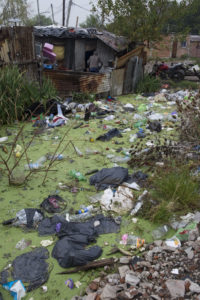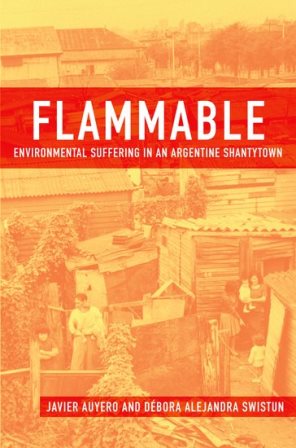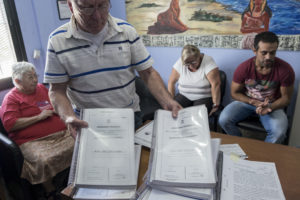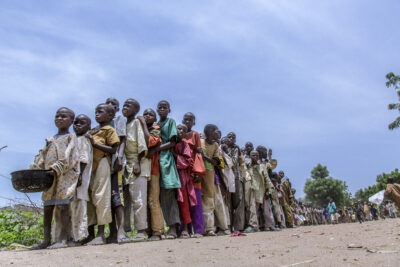The documentation of toxic waste facilities near communities of color by the United Church of Christ in 1987 helped coin the term environmental justice in the United States, and began an important field of study in sociology and beyond.1For example, see
→Robert Bullard, Dumping in Dixie: Race, Class and Environmental Quality (Westview Press, 2000).
→David Schlosberg, Defining Environmental Justice: Theories, Movements and Nature (Oxford: Oxford University Press, 2009).
→Dorceta Taylor, Toxic Communities: Environmental Racism, Industrial Pollution and Residential Mobility (New York: NYU Press, 2014). The environmental justice movement—developed in the context of race- and class-based exclusion in the United States and linked to the civil rights movement—was a corrective to an American environmental movement that was largely conservation-based and less interested in challenging systemic economic and social disenfranchisement. Yet, this term and its implications are now more relevant than ever. Communities in the United States and throughout the world are witnessing attacks on the quality of the air, water, and land they depend on for maintaining their health and economic livelihoods. It is notable that the activism of the United Church of Christ in the 1980s in documenting exposure to toxic contamination and seeking remediation from the state continues to be a model for resisting the impacts of toxic exposure for communities around the world.
In research for a new book project, I examine how communities impacted by toxic contamination, particularly related to untreated sewage and solid waste in urban waterways, are mobilizing to demand remedies from the state in Latin American cities. In the process of mobilization, I explore how citizens are demanding that the government recognize the right to a clean environment—activating what I term environmental citizenship—even for the poor and disenfranchised communities that have often been forgotten. Communities in Buenos Aires, Argentina, and Bogotá, Colombia, are working with NGOs and activists to create broad-based movements to address the environmental injustices they face.
“The contamination can be felt, touched, and smelled”
In the outskirts of Buenos Aires, garbage trucks hauling hundreds of thousands of tons of the city’s waste turn a corner into the residential streets of González Catán. There, neighbors watch as approximately two thousand trucks daily make their way to a regional landfill. Birds and other wildlife scavenge throughout the mostly open air landfill as it leaks toxic effluent into the streams that converge with the Matanza-Riachuelo River and the rest of Buenos Aires. In adjacent neighborhoods, children play around the liquid toxins that seep into their yards and pick at squash and tomato plants born from a soil bed of dirty diapers, car parts, and organic waste. During an interview I conducted, residents describe how in the early 2000s, an epidemiological survey organized by local elementary schools revealed a community sick with autoimmune disorders and that studies had shown the town’s water supply was no longer potable. The pollution crisis in the Matanza-Riachuelo River basin has many sources: 65 percent of the population lacks residential sewage connections, over thirteen thousand industrial facilities dump untreated manufacturing waste directly or indirectly into the river, and a Shell petrochemical processing plant transmits soil, water, and air toxins into the densely populated shantytown of Villa Inflamable in the river’s lower basin. The river floods frequently during the rainy season, spreading highly polluted water throughout informal settlements.2World Bank, Project Appraisal Document on a Proposed Adaptable Program Loan; Matanza-Riachuelo Basin Develoment Program Phase 1 (WorldBank, 2009). Residents suffer from diarrhea, respiratory problems, anemia, neurological disorders, skin diseases, lead poisoning, and cancer.

Similar dynamics surfaced in the other side of the continent. Residents interviewed from the Bogotá neighborhood of the Conejera described how, when they moved into the newly built apartment complex in the 1990s, outside their front door waterways were filling up with construction debris such as bricks, pipes filled with asbestos, and insulation, discarded by construction industry trucks during surreptitious nighttime dumps. This waterway interacts with the Bogotá River basin, which was increasingly contaminated by untreated industrial, chemical, and residential sewage. As neighbors began to document the unique flora and fauna native to what they determined to be a wetland, they noticed increases in skin lesions and pulmonary disorders in their children. Further south in the Bogotá River basin, the hydroelectric Muña Dam sits adjacent to the municipality of Sibaté, where residents are exposed to polluted water daily when it is sprayed during electricity generation. This process emits sulfuric gas and toxins that sicken livestock and generates health effects such as gastrointestinal, respiratory, and skin infections. A 1996 Colombian newspaper article captures the essence of the problem: “The contamination can be felt, touched, smelled; in what was several decades ago a temple for flora and fauna, today it is milk for the dead.”
The global sewage crisis
The World Health Organization (WHO) reports that 12.6 million people die annually from living or working near toxic pollution, amounting to a quarter of the world’s deaths. A 2016 WHO report stresses that the majority of these deaths impacts residents of low-income countries.3Annette Prüss-Ustün, Jennyfer Wolf, Carlos F. Corvalán, R. Bos, and Maria Purificación Neira, Preventing Disease Through Healthy Environments: A Global Assessment of the Burden of Disease from Environmental Risks (World Health Organization, 2016). Toxic contamination from untreated sewage is a growing, global problem that, in the words of one UN task force, “has been ignored by the international community.” If only one out of three people have access to toilets, it is not surprising that globally only 20 percent of wastewater receives treatment, and this figure lowers to 8 percent in the case of developing countries.4WWAP (United Nations World Water Assessment Programme), The United Nations World Water Development Report 2017. Wastewater: The Untapped Resource (Paris, UNESCO, 2017). The global sewage crisis is due not only to the lack of treatment for residential wastewater, but also to the minimal treatment that industrial, agricultural, and medical wastewater receive, and the associated problem of solid waste dumping into freshwater sources. This problem is particularly pronounced in developing world cities, where the majority of the world’s population lives.
“Toxic waterways in Latin American cities are principal contributors to gastrointestinal illness, child mortality, and limited economic and social development.”Exposure to toxic waste, air-borne and water-borne industrial pollutants, and raw sewage is increasing throughout the developing world as rapid industrialization outpaces enforcement of regulations designed to protect both the environment and the health of millions of urban residents. In Latin America, where 80 percent of residents live in cities, toxic contamination in urban centers is swelling, with 85 percent of untreated residential wastewater routinely dumped into rivers, lakes, and wetlands,5Andrei Jouravlev, Drinking Water Supply and Sanitation Services on the Threshold of the XXI Century (United Nations Publications, 2004). along with unregulated dumping of industrial, medical, and agricultural waste. Toxic waterways in Latin American cities are principal contributors to gastrointestinal illness, child mortality, and limited economic and social development. While the increasing pollution of urban waterways impacts all residents, the urban poor, who often live next to or on top of untreated wastewater, are disproportionately affected. As Javier Auyero notes, “the poor do not breathe the same air, drink the same water, or play on the same playgrounds as others.”6Javier Auyero, “Researching the Urban Margins: What Can the United States Learn from Latin America and Vice Versa?” City and Community 10, no. 4 (2011): 431–36. Toxic dumping and riverways pollution most often occur near the dwellings of the poor, making environmental inequality an important, yet understudied, dimension of socioeconomic inequality.7 Oxford University Press, 2009More Info → Historic marginalization, whether it be race- or class-based, creates barriers to mobilization, such as limited time, money, and resources for organizing.
Oxford University Press, 2009More Info → Historic marginalization, whether it be race- or class-based, creates barriers to mobilization, such as limited time, money, and resources for organizing.
Mobilizing grassroots activism and crafting environmental citizenship
Yet, despite the odds, historically marginalized communities impacted by toxic exposure are organizing to assert their rights and initiate powerful change. Returning to the Buenos Aires and the Bogotá River basins, broad-based advocacy networks formed to address a diverse set of grievances throughout the two respective river basins, such as exposure to toxic effluent, lack of toilets, potable water, and health services. In Buenos Aires, local groups, such as Neighbors Organized Against the CEAMSE in González Catán (Vecinos Autoconvocados contra el CEAMSE) in the municipality of Lomas de Zamora, organized rallies and sit-ins to demand more sustainable waste management policies and health services for impacted residents. They filed numerous legal petitions and created participatory forums to build a broad base of grassroots support.

The Hydraulic Forum (Foro Hídrico) is a grassroots group in the municipality of Lomas de Zamora in Greater Buenos Aires that conducted epidemiological studies to document lead poisoning in children. Professional civil society organizations, journalists, academics, and government activists joined these grassroots groups. What was initially a set of local issues became coupled with the language of rights, helping to incorporate a wide group of domestic civil society organizations focused on human rights, legal rights, and strengthening democratic institutions. These networks helped construct a class action lawsuit, where the Supreme Court ruled in 2008 in favor of the collective right to a clean environment, ordering the relocation of impacted communities and mandating industrial regulation enforcement and river cleanup to hundreds of industries and government agencies. As one Argentine public official in the ombudsman’s office noted, widespread advocacy “changed the conversation about collective rights in the country.”
“These initiatives helped connect many formerly disconnected people into a loose network.”Similar mobilization emerged along the Bogotá River. The Conejera Wetlands Foundation formed to confront a powerful construction industry controlled by local politicians that was using Bogotá’s wetlands as a landfill for their construction refuse. The Conejera Wetlands Foundation’s many efforts—from creating training sessions for activists, biologists, and fauna experts to political lobbying and lawsuits—became a model of environmental advocacy in Colombia. These efforts led to the Bogotá city government adopting a wetlands preservation public policy in 2006. More activists started appearing, some emerging from the Conejera training programs and others creating their own groups spontaneously. In 2004, “We are the Bogotá River” was formed, a multigroup collective that coordinated citizen participation and gathered thousands of signatures for a “water as human right” congressional referendum. These initiatives helped connect many formerly disconnected people into a loose network. Through multiple interviews, it was clear that the many activities of these local organizations increased public awareness of the public health and environmental crisis surrounding the contaminated Bogotá River.
Legal mobilization helped citizens articulate their rights to authorities. A resident of Sibaté named Gustavo Moya Ángel initiated a legal action against the Bogotá power company responsible for the hydroelectric Muña Dam. This was the first of many legal suits waged on behalf of Sibaté against the various entities responsible for the contamination of the Bogotá River and the Muña reservoir. A magistrate judge grouped all legal filings against the contamination into a historic ruling in 2004 that found seventy-two entities, including forty-two municipalities and seven ministries, responsible for the contamination. The ruling collectivized the complaints, stating that the environmental damage was “disperse,” and was caused by both purposeful action and the omission or negligence of state actors.8Everaldo Lamprea, “Daño ambiental y sentencias de reforma estructural: El caso del Río Bogotá,” in Nuevas tendencias del derecho administrativo, ed. Helena Alviar García (Bogotá: Universidad de Los Andes, 2016). In 2014, the Colombian Administrative High Court (Consejo de Estado) upheld the lower court’s ruling after another round of public consultations, including seventeen working groups, four public hearings, and fifty informal interinstitutional meetings.9M.P. Marco Antonio Velilla, Consejo de Estado, Sala de Lo Contencioso Administrativo, Sección Primera, Acción Popular (2014).
Securing environmental justice is about attaining environmental protections in order to defend human health, social development, and economic livelihoods. Prior research on environmental attitudes was primarily based on developed countries and suggested that environmental concerns were correlated with economic wealth, implying that in settings with low-income populations, environmental concerns would be of less importance.10For example, see Axel Franzen and Dominikus Vogl, “Two Decades of Measuring Environmental Attitudes: A Comparative Analysis of 33 Countries,” Global Environmental Change 23, no. 5 (2013): 1001–8. Yet, newer research is showing how proximity to environmental degradation is mobilizing a wide range of citizens throughout local communities, even in resource scarce settings.11For example, see Todd Eisenstadt and Karleen West, “Opinion, Vulnerability, and Living with Extraction on Ecuador’s Oil Frontier: Where the Debate Between Development and Environmentalism Gets Personal,” Comparative Politics 49, no. 2 (2017): 1. While there is a long road ahead in securing environmental rights in Latin America, the examples from my ongoing research show how organized grassroots mobilization partnered with well-resourced actors, such as professional NGOs and legal activists, is helping to create a multipronged attack against toxic contamination and environmental degradation. In the process, citizens are exercising citizenship rights through the demand for environmental protections, and constructing environmental citizenship in unexpected places.
Banner photo credit: Pepe Mateos
References:
→Robert Bullard, Dumping in Dixie: Race, Class and Environmental Quality (Westview Press, 2000).
→David Schlosberg, Defining Environmental Justice: Theories, Movements and Nature (Oxford: Oxford University Press, 2009).
→Dorceta Taylor, Toxic Communities: Environmental Racism, Industrial Pollution and Residential Mobility (New York: NYU Press, 2014).














